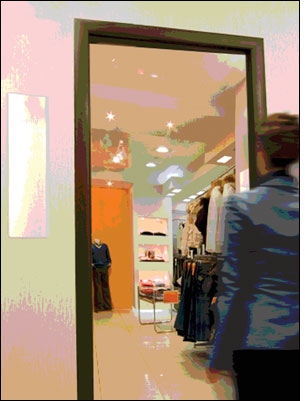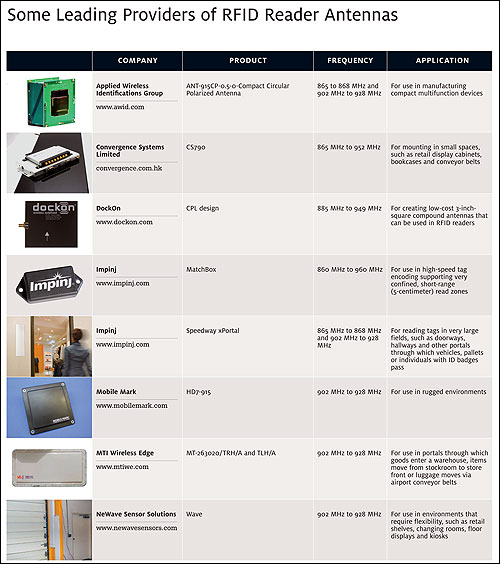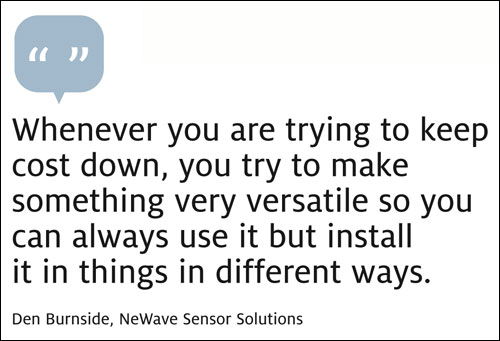As RFID solution providers develop vertical applications that make it easier and more cost-efficient for end users to deploy the technology, RFID hardware vendors are doing their part by designing innovative reader antennas for passive systems. “The antenna is one of the most important parts of the system when it comes to making an RFID reader system application-specific,” says Scot Stelter, Impinj’s senior director of product marketing.
That’s because the antenna’s efficiency, gain (power) and beam width can determine how fast and accurately the reader captures tag information. In addition, factors such as gain, orientation and polarization impact the distance at which a tag can be read. “If you have an application whose read rate is insufficient and you want to increase the read rate, you change the antenna and you get better system performance,” says Reuven Drori, MTI Wireless Edge RFID sales and marketing director.
Early RFID installations typically depended on patch antennas, which radiate a single beam in a given direction. That meant systems integrators had to spend a lot of time figuring out how to cover different zones for each application. And patch antennas often caused unwanted tag reads.
Today’s RFID reader antennas let you monitor everything from jewelry on a store shelf to mining equipment in a hazardous environment. In addition, vendors are developing more efficient manufacturing processes that promise to lower costs. What follows is a look at recent innovations from some leading technology providers. For more details about each reader antenna, see the table on page 33.
For Small Spaces
Retail display cabinets, bookcases and conveyor belts have limited space for mounting antennas, so Convergence Systems Ltd. (CSL) designed the CS790 line of monostatic antennas for use with ultrahigh-frequency (UHF) readers to fit in these environments. The ultrathin antenna—roughly 6 millimeters thick—comes in three standard as well as custom lengths, and has backings for use on metal or nonmetal surfaces. It includes a cable that connects to a CSL UHF reader.
The evanescent RFID antenna technology and CSL’s proprietary design provide a controlled read range. The read zone is confined on top of the antenna and only within a prescribed distance from the antenna’s edge. A tagged item won’t be read when it is moved out of range. So, for example, a retailer could use the information from the reads—or lack thereof—to determine how often customers pick up certain items.
“Historically, antennas did not have the ability to regulate RF fields as we are talking about,” says Jerry C. Garrett, CSL managing director. “Not only can we regulate an RF field, but by regulating an open shelf of jewelry or shoes or garments—and providing control in a very narrow area—we can give a retailer a lot of useful data.”
The ongoing activity at the item level can matter more than the sale itself, he says. It shows a retailer that the same sweater has been picked up and put back five times in a row, for instance, so maybe it’s worth sending someone to investigate whether there’s an issue preventing customers from holding on to that item.
For High-Performance Portals
The Speedway xPortal reader system, from Impinj, is designed for doorways, hallways and other portals through which vehicles, pallets or individuals with identification badges pass. The company claims the xPortal will save businesses an average of $1,000 per doorway, because it’s smaller and less expensive to install than conventional readers. “In the old days, you’d put general readers around dock doors with four general-purpose patch antennas,” Stelter says. “This created a blob of RFID around the portal and, hopefully, it read everything around it.”
The xPortal includes the vendor’s Dual-Linear Phased Array (DLPA) antenna technology, which can read all the tags in a very large field. The DLPA enables the reader to detect and dynamically manage the location and orientation of the tags at high speed.
Click Click here to view a larger version of the above image.
“Say there are 400 tags on a pallet,” Stelter says. “The challenge for RFID systems is to get as close to 400 as possible in as short a time as possible.” The DLPA can achieve this, he adds, without workarounds, such as driving more slowly to make sure more tags are captured as a vehicle moves through a portal.
MTI Wireless Edge takes a different approach to improving portal read rates for goods entering a warehouse, items moving from a stockroom to the front of a store, or luggage moving along airport conveyor belts. Its MT-263020/TRH/A and TLH/A antennas maximize the advantages of circular polarized models—tags can be read at any orientation—while avoiding the pitfalls, Drori says.
Most circular polarized antennas are low-gain and wide-beam symmetrical, which can lead to low read rates and false reads when they are installed in portals; they cover a wider area than required. In the asymmetrical beam-width MT-263020/TRH/A and TLH/A circular antennas, the azimuth beam is narrower than the elevation beam. “By focusing the beam width to the portal dimensions with our antennas, we minimize [low or false read rates],” Drori says.
The two antennas are designed to work together, one on each side of a portal. “By using right- and left-hand antennas, the antennas don’t get interference” from each other, as they would if both were positioned to perform clockwise or counterclockwise reads, he says. This also contributes to the higher read rate, he adds.
For Efficient Encoding
The MatchBox antenna, also from Impinj, is designed to meet the high-speed tag-encoding requirements particularly pressing in the retail apparel sector for clothing suppliers and service bureaus that program tags for them. According to the company, the MatchBox antenna—sized and shaped as its name indicates—is the smallest antenna on the market for UHF Gen 2 readers. It gives businesses the flexibility to mount it in existing structures, such as printing systems that previously printed labels on apparel without RFID tags.
The MatchBox antenna can support very confined, short-range (5-centimeter) read zones. A tightly controlled read distance is required for applications such as encoding tags on a web of inlays or labels spaced approximately 1 inch apart.
It’s important to avoid stray reads during in-line encodings, when machines run rolls of tags across an antenna at high speeds, Stelter says. “That requires an antenna to have a very small field, so you can focus on a single tag, one at a time, as it flies by,” he adds.
For Rugged Environments
Mobile Mark’s HD7-915 antenna was developed to meet a customer’s challenge: The client’s commercial vehicles were constantly exposed to weather and road elements—water, dirt, salt—and its existing RFID system had high failure rates. The company needed a vehicle-mounted antenna that would provide consistently high read rates.
“You have a heavy-duty reader mounted inside a cab and protected from the elements, but if you put a regular antenna outside the vehicle that is not rated for those weatherproof or vibration specs, the antenna could fail quite quickly,” says Ken Lukowski, Mobile Mark’s VP of sales. “This one holds up to whatever is thrown at it.”
The HD7-915 is a standard circular polarized antenna, with a fairly narrow footprint to fit in a limited space, and a housing that enables the radiating element to withstand severe vibration. A heavy-duty plastic enclosure, with reinforced metal grommets at mounting positions, protects the antenna. The HD7-915 passed numerous standard shock and vibration tests, including the EN-61373, IEEE-1478, MIL-810G and TIA-329.2-C.
In addition to trucking, Lukowski says the applications for this antenna include forklifts, restaurant freezers, food processing rooms that are regularly power-washed, and earth-moving and mining equipment.
For Retail Flexibility
NeWave Sensor Solutions designed its Wave antenna to uniformly illuminate a volume of space. When installed in pairs, the Waves complement each other to cover all three tag orientations—spatial, direction-of-arrival and polarized—within a user-defined zone up to 10 cubic feet. Big zones can be broken into contiguous or noncontiguous 10-cubic-foot units.
With four 7-foot NeWave antennas mounted vertically in a typical 8-foot metal retail shelving unit, retailers can adjust shelf height and still read tagged items. The antennas also can be used to create a zone in a changing room or on a sales floor to read, for example, a display of vacuum cleaners. “We designed our antennas to have as much diversity as possible,” says CTO Den Burnside. “Whenever you are trying to keep cost down, you try to make something very versatile so you can always use it but install it in things in different ways,” he explains.
Brands that own kiosks in retail stores could create a zone for each kiosk. Imagine, Burnside says, a brand’s rotating sunglass tower at 100 Macy’s stores with NeWave antennas installed in them. “Each one could be a zone, and you could have data sent off that rotating tower to you at a central site, and all it looks like is 100 different zones,” he says. “So you know exactly what’s on each rotating tower even though you’re not there, and you can tell what inventory you need at each site without sending people out to check.”
For Multifunction Devices
Some end users want handheld devices that can read bar codes and RFID tags, or combine RFID and closed-circuit television capabilities to support facial or license-plate recognition—or all of the above. The applications include warehouse management, access control and vehicle identification. But to merge technologies so they don’t conflict with each other can result in a heavy, nonergonomic device.
Applied Wireless Identifications Group (AWID) wanted to give manufacturers a way to “shrink everything into one compact package,” says CTO Eric Huang. To that end, it developed the ANT-915CP-0.5-0 Compact Circular Polarized Antenna. The design colocates the antenna and optical devices in a cavity, integrating them so the optical or imaging device doesn’t have to be separated physically or located outside the main structure.
Using this antenna technology, AWID says, one of its RFID bar-code readers that typically requires a 6-inch x 3.5-inch area needs only 2.75 inches x 2.75 inches. AWID is working with several manufacturers to combine the ANT-915CP-0.5-0 with their video security and handheld devices.
For Less Costly Manufacturing
As flat (planar) patch antennas shrink below their typical 8-inch-square size, thanks to engineering that makes the electrons behave as if they’re resonating at the same speed in a smaller space, they become more expensive to manufacture. Companies have tried unsuccessfully for years to build flat compound antennas to substitute for flat patch antennas; they used external transmitters to separately feed electrical energy to the two antennas that form the compound and reside near each other.
DockOn has figured out how to cost-effectively build a 3.0 or 3.5 DeciBel Isotropic compound antenna on a 3-inch square of FR-4, the inexpensive fiberglass used to make circuit boards. The loop antenna feeds electrical energy to the monopole antenna, and vice versa. The company mathematically maps the antenna properties—as well as relationships among components and tuning to manufacturer’s requirements—into software that resides on a supercomputer, which returns a 90 to 95 percent accurate design rendition. “This goes to an FR-4 printer, which prints out the antenna design we put in the physical device,” says CEO Patrick Johnston. “We measure it, and it works.”
Manufacturers can use DockOn’s CPL design technology and software to create custom passive compound antennas for RFID readers or other devices, Johnston says. “A 3-inch-square antenna could be manufactured for pennies” using standard fiberglass materials, he adds. If manufacturers pass these savings on to their customers, clients could wind up getting good deals too, he notes.




